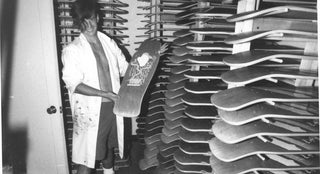With an aesthetic defined by artist Ron Cameron’s pastiche of Fillmore poster typography butted against bold, painterly illustrations and a revolving cast of recognizable riders, Blockhead Skateboards grew from a pizza delivery boy’s garage dream into a full-fledged international skateboard brand. Founded by Dave Bergthold in Sacramento, California, in 1985, Blockhead was an industry outlier, independently existing and thriving without the help of the larger companies—Powell Peralta, Vision, or Santa Cruz—before securing a licensing deal with Larry Balma and Tracker Trucks. The term “skater-owned” had yet to become cliché and was what drove Bergthold to pursue his dream of owning a brand, building his dream ramp, and most importantly, avoiding the malaise of holding down a bullshit day job. The thought of starting a company at a time when skating was in a major transition—invisible to the mainstream in the wake of the great concrete park exodus of the 1970s—didn’t influence his impulse.
“I wanted to work in skateboarding, because that’s all I cared about,” he said. “Skateboarding was absolutely fucking dead at that point,” he said of the industry landscape of the industry in 1985. “There were magazines and there was a scene, but you could count the number of skateboard companies on your fingers and toes. I was working delivering pizzas and saved up about $3,000. I ended up buying a batch of boards—about 60 decks total, because that’s what they [Uncle Wiggly] could make a day. I decided I needed an ad in Thrasher, so people would take me seriously. I don’t remember how much it cost, but it had to be around $800, so I spent almost a quarter of my budget just on this one ad.”
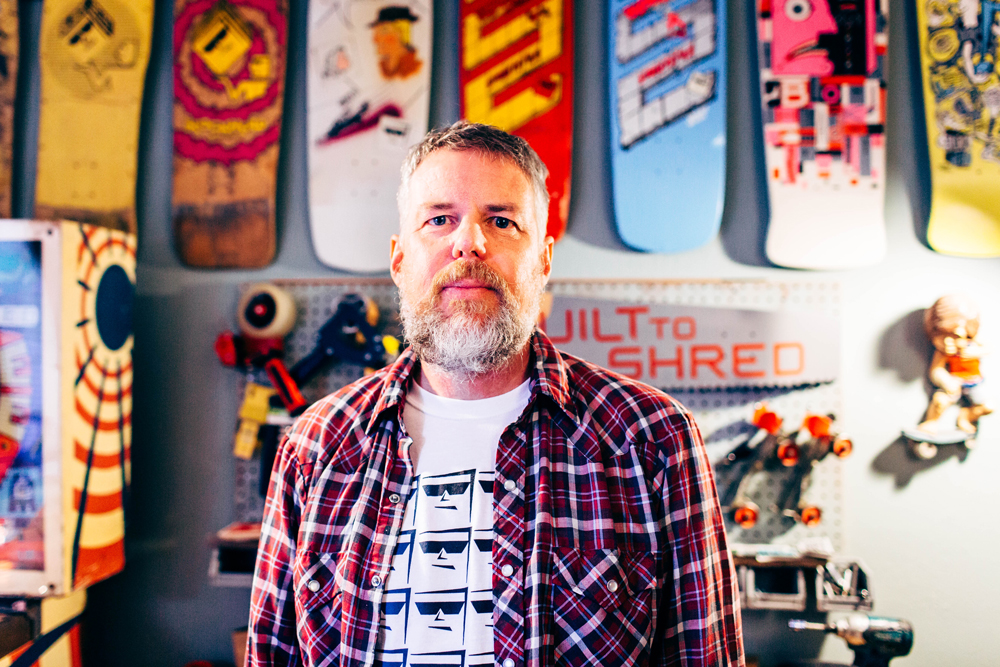
Dave Bergthold
Bergthold had some woodworking experience and knowledge of making boards and intended to manufacture his product on his own, but was convinced by Uncle Wiggly that it would be easier for them to handle the production and screening of his early runs. He quickly formed a team, cemented by a local all-terrain ripper named Sam Cunningham, making Blockhead the most active and prolific brand Sacramento had seen to date. Local demand was high, and it was obvious to Bergthold that he was outgrowing his parent’s garage, after only a year.
“The past is a nice place to visit, but I wouldn’t want to live there…”
“It was actually an old dentist’s office, which [was] a pain in the ass, because it was 1,200-square-feet and about 10 rooms—it was tough to navigate around there,” he said about the brand’s first official space. What was a boon for the brand was the location, as the former tooth hospital was located directly behind a shop called Skates Plus, which provided a small distribution lane for the young company. With the shop moving product daily, Blockhead could walk boards over, avoiding shipping costs, meeting the local demand.
The industry giants had investors, backers, warehouses, full staffs, budgets for paid riders, product developers, marketing budgets, and overall resources that weren’t available to a twenty-something living at home. DIY companies weren’t supposed to happen, let alone thrive, but Blockhead’s growth was local, organic, and completely unplanned. There was no blueprint, no Google to find factories or Instagram to shill products, so Blockhead’s growth alone was a milestone. It seemed that his internal business acumen was driving the brand in the right direction, but Bergthold does admit there were misfires along the way, including a forward-thinking board shape, that predated the modern popsicle.
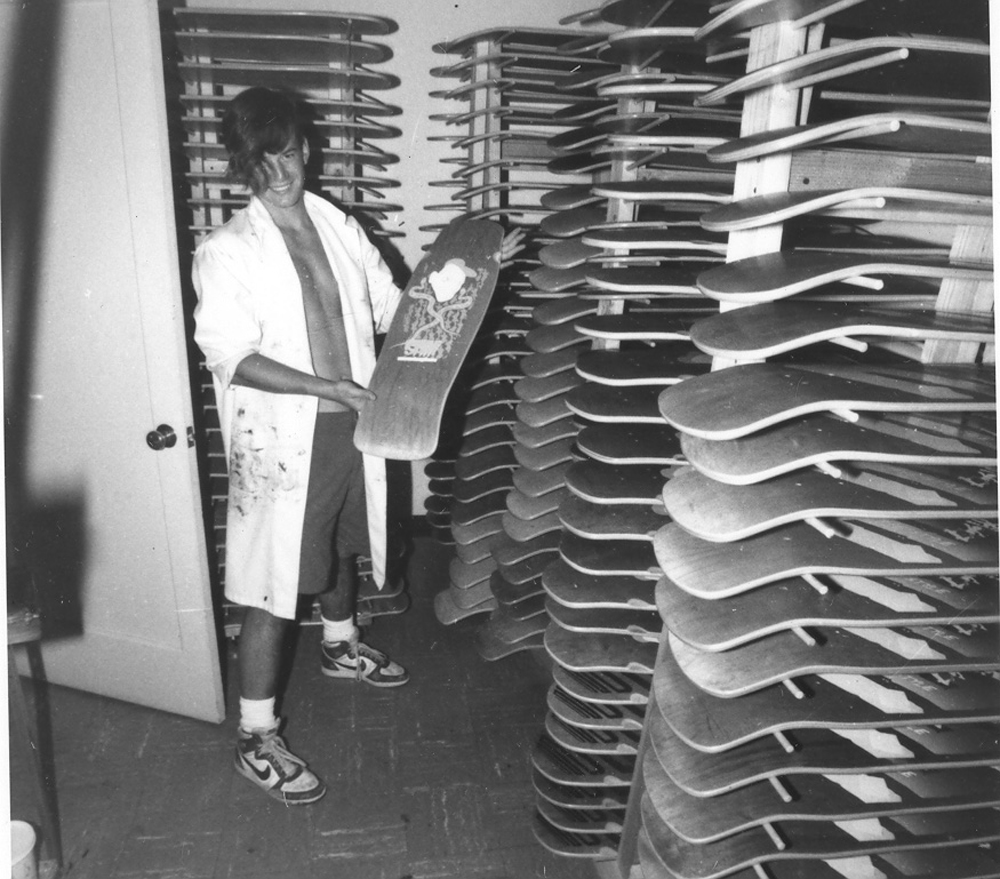
“The Street Style board was fairly innovative at the time [in 1985],” he said. “It was based on a freestyle board and had a longer nose than anything on the market. It was a four inch nose, when most boards had a three inch one, but it was more full. It was a round shape, but it quickly became about the ‘money bumps.’ Boards had to be recognizable by their silhouette. One of my bigger regrets was not taking that Street Style board and evolving it. I started in the right direction, but didn’t follow through, but we weren’t pressing our own boards and doing our own concaves, so we were also limited.”
For that first year of Blockhead, Bergthold was the owner/founder/CEO/CFO/sales manager, art director, and whatever other title that was vacant: His money, his hustle, and his vision. So, like any good Hiring Manager (that position was open, too) he found talent, employing team rider Ron Cameron to create graphics.
“I wanted to work in skateboarding because that’s all I cared about.”
“He started out as strictly a team rider—just a teenager,” he said. “I’d seen some of the drawings on his griptape, but they weren’t refined. Then he asked me to check out some of his doodle books and was blown away. We started collaborating on logo designs, ads, and graphics. Pretty soon it was obvious that he should do it all.”
With skate stalwart Jim Gray in the mix, Blockhead got a break—a massive one, actually. Gray had a relationship with industry mogul Larry Balma (Tracker Trucks/Transworld Skateboarding Magazine), and suggested that Tracker license Blockhead, rather than start a new board brand as Balma intended. The deal not only allowed Bergthold to move out on his own, but buy a house with enough land to build his dream ramp, to the tune of between fifteen to twenty thousand dollars. The Blockhead Ramp became the brand’s training facility and proving ground for a prodigy named Omar Hassan, a neighbor of Gray’s.
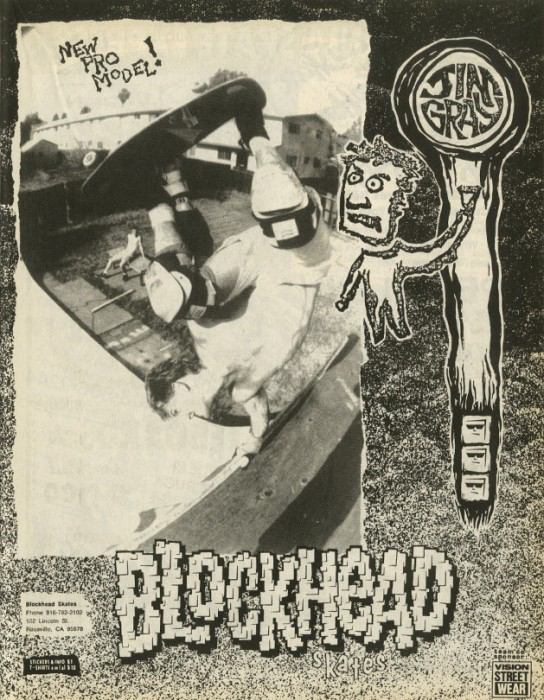
The brand packed up to Oceanside, California, to be closer to Transworld, allowing Bergthold to ditch his parents’ digs and the mattress he frequented at Blockhead HQ, when he needed a little “adult privacy.” Through Tracker, Blockhead secured more riders around the US, as well as through scouting at contests, and yes, sponsor me tapes. It became a weekly ritual for the team to post up with some beers and view the VHS calling cards. Most were ejected quickly, but one Canadian skater’s tape broke through the static, giving Blockhead not only one of their first young street skaters, but a rider that would drive progression throughout the ‘90s.
“His sponsor me tape started with this countdown: ‘Five-four-three-two-one,’ with this pulsing heartbeat sound—bump bump-bump bump. It was totally professionally edited and the skating blew us away. It had so much innovative street stuff—hitting handrails and all that. I guess his mom knew someone who had a video production studio, so he was able to put together this really professional video. Regardless, he didn’t need all that, because his skating spoke for himself. Also, in all his footage he was riding Blockhead boards; he wasn’t some kid sending out tapes to every company, hoping someone would take notice.”
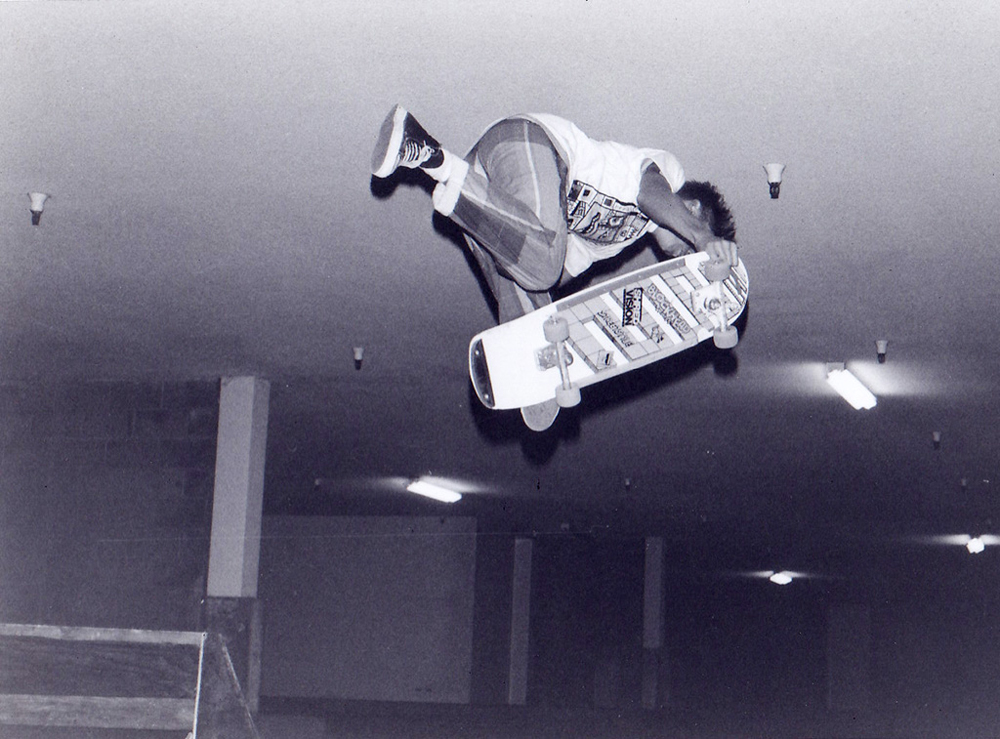
Rick Howard’s arrival around 1988 came at time when transition skating was starting to transition out of skating. In the next few years, Gray and Cunningham stepped out of the brand’s frontlines, allowing Howard and the new crop of riders to define the brand. They proved themselves a forward-thinking brand, with their cult classic “Hard Times” series, a simple one-color graphic line, with simple graphics and a cheaper price tag for the same quality.
As the new decade approached, no one was entirely sure where skating was headed or if it would even survive as an industry, but it was clear that the accessible streets—not backyard ramps, pools or parks—were going to be where it happened. In fact, anything that conjured up the past, was passé.
“No one wanted to be associated with old school skating,” he said of the transition in the ‘90s. “No pool skating, vert skating, the ‘70s, the ‘80s... everyone felt like the history of skating started now—it was street skating, flip tricks, big pants and a desire to disconnect from the past.”
Blockhead found themselves in an interesting position, as the brand wasn’t as deeply rooted as Powell or Santa Cruz, but they did have a bit of a dangerous “mid-’80s stink” wafting off them, which could turn off a new generation of skaters, flicking their football shaped boards below billowy clouds of colored denim. Blockhead was suddenly old school. This thirst for new and next meant that riders were leaving their old sponsors for newer brands or to start their own. Though the brand’s graphics drifted away from Cameron’s aesthetic, they found their audience through a new team that boasted Jason Dill, Laban Pheidias, technical savant Rick Jaramillo, a young vert contest crusher named Steve Berra, and a youngster ready to take on terrain that only Frankie Hill and a newcomer named Patrick Duffy had attempted.
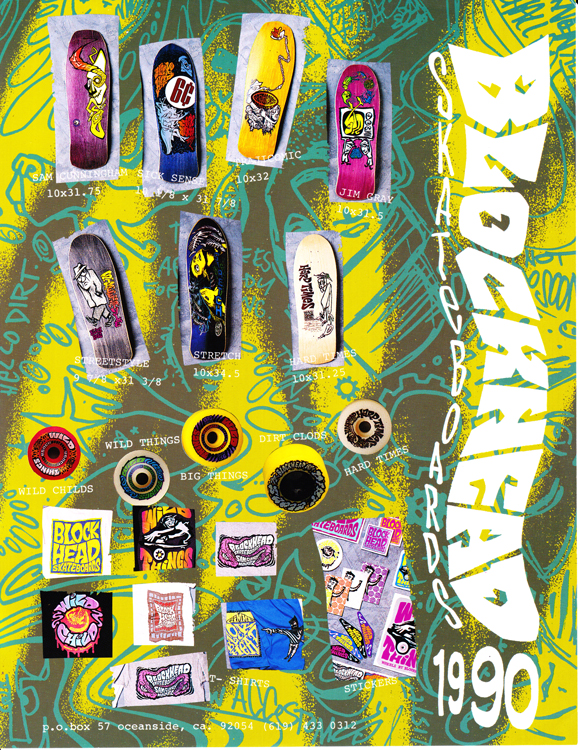
Jeremy Wray literally propelled himself into skate conversations by leaping down the unimaginable, with confidence and style, including a stand out part in Debbie Does Blockhead (1992). Like Hill, Duffy, and Markovich, Wray’s speed and determination shaped “big skateboarding,” by taking technical tricks to landmark obstacles, that many would be content just ollieing down. And surprisingly, despite all the trauma put on his lanky frame, Wray’s still actively skating and running a company (Wray Bros) with his brother Jonas.
“I think he sent a video to Black Label also,” Berghold said of Wray, one of the brand’s most pioneering riders. “Lucero had given him a few boards at a trade show. He came by our booth and we told him we wanted him on, so he went back and returned the boards to John and got on Blockhead, right there.”
Unfortunately for Berghold, this was also an era where World Industries’ dominance was so overarching, that many smaller brands’ videos acted as sponsor me tapes for World. Howard was poached for the original incarnation of Plan B, Wray departed for Color and later Plan B, Dill ended up on 101, Jaramillo Planet Earth, and the list goes on, with Pheidas being one of the only mainstays on Blockhead.
The ’90s were incestuous and defined by the quiet panic of industry instability.
Yes, the ‘90s were incestuous and defined by the quiet panic of industry instability. The elders tried to adapt to the new product innovations and graphic trends, eschewing the aesthetics that defined their lot. Most would eventually return to their roots in the 2000s, flooding the market with reissues, but Berghold split his hand, like a blackjack player, creating Invisible as a fresh brand, and using Blockhead as a vehicle to sell old school boards and reissues in the mid-’90s.
“I tried to keep Blockhead going for a while, with the first Invisible video coinciding with the last Blockhead video (Girl Trouble, 1994), but it wasn’t worth it,” he said of the move to run two brands. “It’s funny though, because at that point, it really became one of the first ‘retro’ companies. No one wanted to make boards over 8”s wide or wheels over 53mm. With Blockhead, I wanted to make big stuff, because I knew people wanted to ride it and I wasn’t afraid to be associated with it. It actually worked for about a year, but then other brands with more clout started making bigger boards and we eventually pulled the plug.”
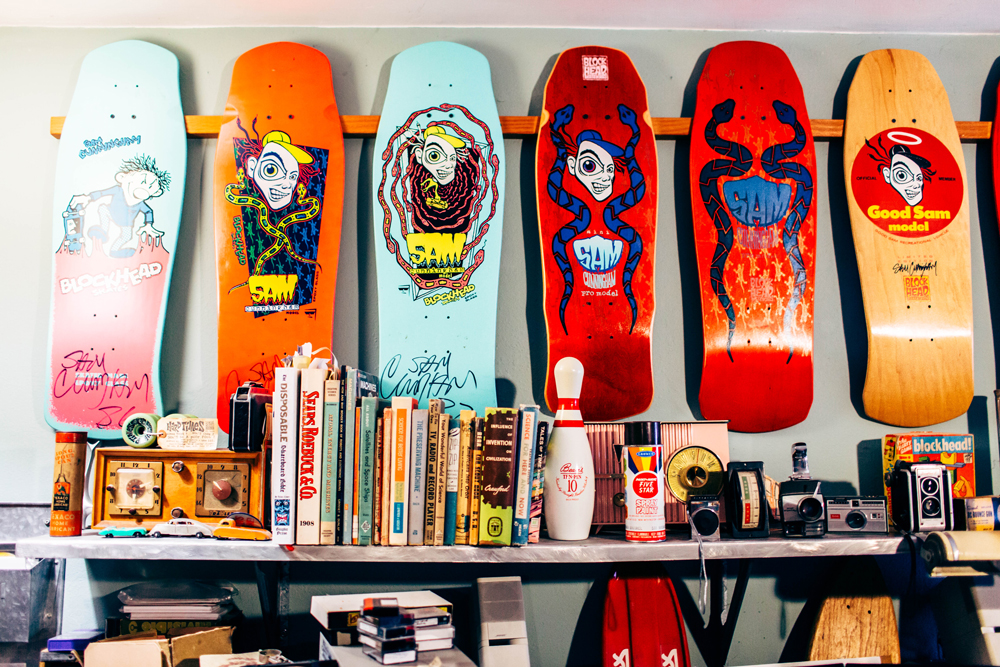
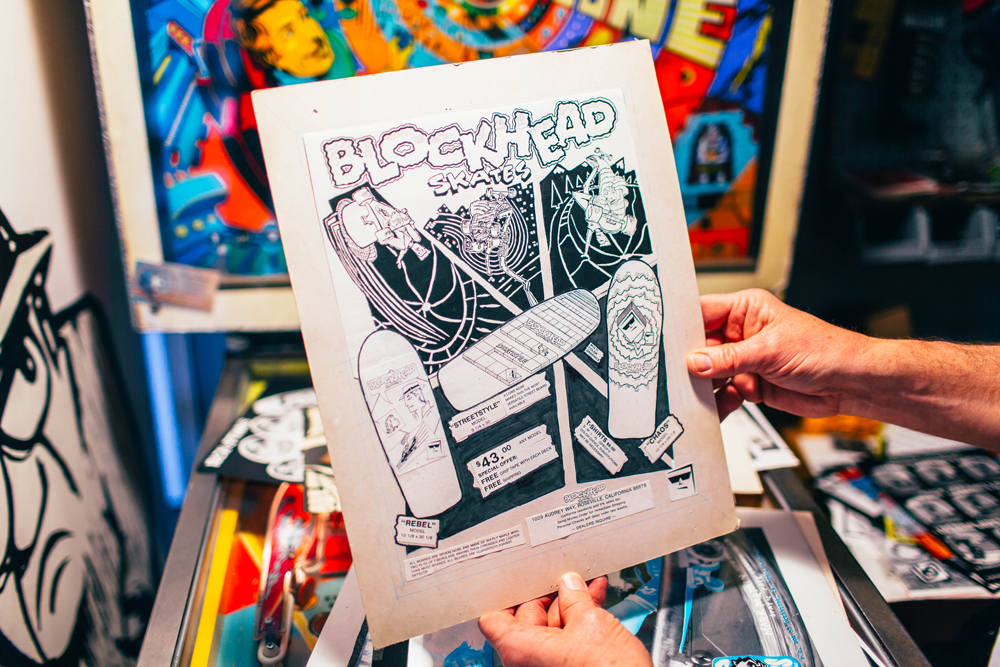
Invisible carried on into the late-’90s, launching Jamie Thomas’s career, but failed to find a place in skating. Bergthold and Blockhead’s finances were constantly in flux, stemming from complications and alleged embezzlement at Tracker, along with the unpredictability of the industry at large. Neither Blockhead nor Invisible were able to capitalize on Cameron’s art direction, as he was employed by Transworld, so merely utilizing him to create a graphic meant filing a work order with some corporate operations manager—something both Bergthold and Cameron would eventually tire of. Cameron’s talent wasn’t easily replaceable, and with many of the graphics in the early ‘90s being “rip-off” based, you have to wonder if retaining Cameron would have saved Bergthold’s brands.
Still, Cameron’s art and the brand remain an important sliver or chunk of skate history, depending on who you reminisce with. That interest and lineage, along with last year’s 30th anniversary milestone inspired Bergthold to resurrect Blockhead. Along with a commemorative jam on the latest incarnation of his ramp, complete with the original steel coping from the OG, Bergthold curated a Blockhead art show, which will continue to travel in 2016, and produce small reissue runs, adhering to his high standards.
DIY companies weren’t supposed to happen, let alone thrive, but Blockhead’s growth was local, organic, and completely unplanned.
We talked at length about the economy of dealing in nostalgia, and both shared a disdain for mass-produced, bloated reissue runs of classic boards, often omitting the original rider’s name from the deck. Even in small, calculated runs, the risk is run of only selling memories, something counterintuitive to a brand that was a home to progressive art, product, ideas, and of course, skateboarding. Having doubled his age since he started off green in that Sacramento garage, hoping to last a year or two, Bergthold speaks with as much excitement about skateboarding, as a young skater, still buzzing off that first “Christmas Complete” he acquired over the holidays. He’s thankful for events like the art shows and the 30th anniversary jam—it should be noted that 42-year-old alum Omar Hassan had an excused absence because he had a contest to skate that day—and the interest in Blockhead. That being said, he’s not interested in just “playing the hits,” like some bloated ‘80s hair metal band riding the casino circuit.
“The past is a nice place to visit, but I wouldn’t want to live there,” he says about the future of Blockhead. “I want to take this opportunity to take Blockhead further and make new things, influenced by the old stuff.”
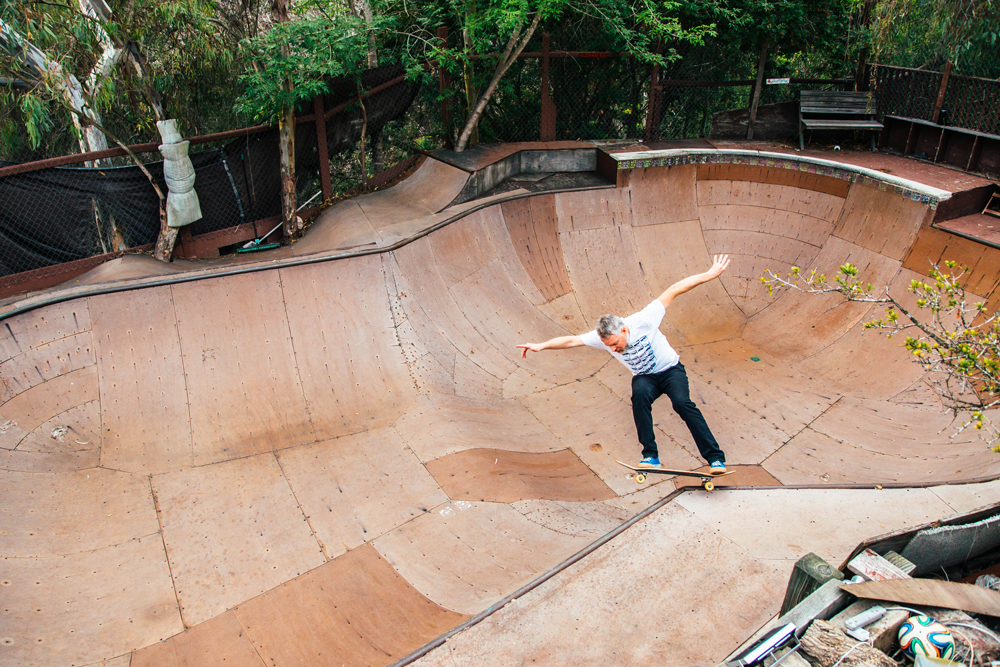
***
This article originally appeared in The Hundreds Magazine Spring/Summer 2016 issue.
Our The Hundreds X Acme Skateboards and The Hundreds X Blockhead Skateboards drops Thursday, September 29, 2016. Find it in our flagships, select retailers, and thehundreds.com.

